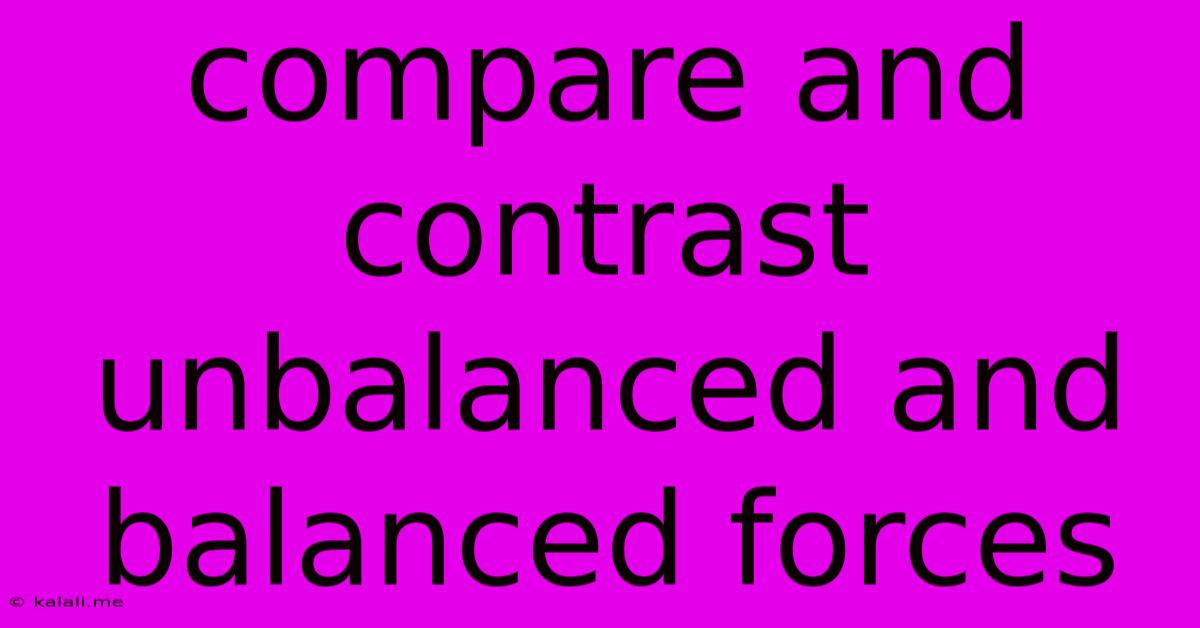Compare And Contrast Unbalanced And Balanced Forces
Kalali
Jun 14, 2025 · 3 min read

Table of Contents
Unbalanced vs. Balanced Forces: A Comprehensive Comparison
Understanding the difference between balanced and unbalanced forces is fundamental to grasping the principles of motion and mechanics. This article will delve into the definitions, effects, and real-world examples of each, clarifying the key distinctions and providing a clear, concise comparison. By the end, you'll have a solid grasp of this crucial physics concept.
What are Forces?
Before diving into the comparison, let's briefly define what forces are. A force is simply a push or pull that can cause an object to accelerate, decelerate, change direction, or deform. Forces are measured in Newtons (N). They are vector quantities, meaning they have both magnitude (size) and direction.
Balanced Forces:
Balanced forces occur when the net force acting on an object is zero. This means that all the forces acting on the object are equal in magnitude and opposite in direction. Imagine two equally strong people pulling on a rope in opposite directions – the rope doesn't move because the forces are balanced.
Key Characteristics of Balanced Forces:
- Net force = 0: The sum of all forces acting on the object is zero.
- No change in motion: An object at rest remains at rest, and an object in motion continues moving at a constant velocity (same speed and direction).
- Equilibrium: The object is in a state of equilibrium, meaning there is no acceleration.
Examples of Balanced Forces:
- A book resting on a table: The downward force of gravity is balanced by the upward force of the table supporting it.
- A car traveling at a constant speed on a straight road: The forward force of the engine is balanced by the backward forces of friction and air resistance.
- A person standing still: The downward force of gravity is balanced by the upward force of the ground pushing back.
Unbalanced Forces:
Unbalanced forces occur when the net force acting on an object is not zero. This means that the forces acting on the object are not equal in magnitude or are not opposite in direction. A single, strong person pulling a rope will cause the rope to move because the force is unbalanced.
Key Characteristics of Unbalanced Forces:
- Net force ≠ 0: The sum of all forces acting on the object is not zero.
- Change in motion: The object will accelerate (change its velocity). This acceleration can be a change in speed, direction, or both.
- No equilibrium: The object is not in equilibrium.
Examples of Unbalanced Forces:
- A ball rolling down a hill: The force of gravity is greater than the force of friction, resulting in acceleration.
- A car accelerating: The forward force of the engine is greater than the backward forces of friction and air resistance, causing the car to speed up.
- A rocket launching: The upward force of the engine is significantly greater than the downward force of gravity, causing the rocket to accelerate upwards.
Comparing Balanced and Unbalanced Forces:
| Feature | Balanced Forces | Unbalanced Forces |
|---|---|---|
| Net Force | 0 | Not 0 |
| Motion | No change in motion (constant velocity) | Change in motion (acceleration) |
| Equilibrium | In equilibrium | Not in equilibrium |
| Acceleration | 0 | Non-zero |
Conclusion:
The distinction between balanced and unbalanced forces is crucial for understanding how objects move and interact. Balanced forces result in no change in motion, while unbalanced forces cause acceleration. Recognizing these differences is key to applying Newton's Laws of Motion to various real-world scenarios. By understanding these fundamental concepts, you can better analyze and predict the behavior of objects subjected to different forces.
Latest Posts
Latest Posts
-
Isobars Are Contour Lines That Connect
Jun 14, 2025
-
Which Of The Following Statements About Divergent Boundaries Is True
Jun 14, 2025
-
The Outermost Layer Of The Suns Atmosphere
Jun 14, 2025
-
Sodium Sulphate And Barium Chloride Reaction
Jun 14, 2025
-
How Many Kilobytes Are In 1 Gb
Jun 14, 2025
Related Post
Thank you for visiting our website which covers about Compare And Contrast Unbalanced And Balanced Forces . We hope the information provided has been useful to you. Feel free to contact us if you have any questions or need further assistance. See you next time and don't miss to bookmark.